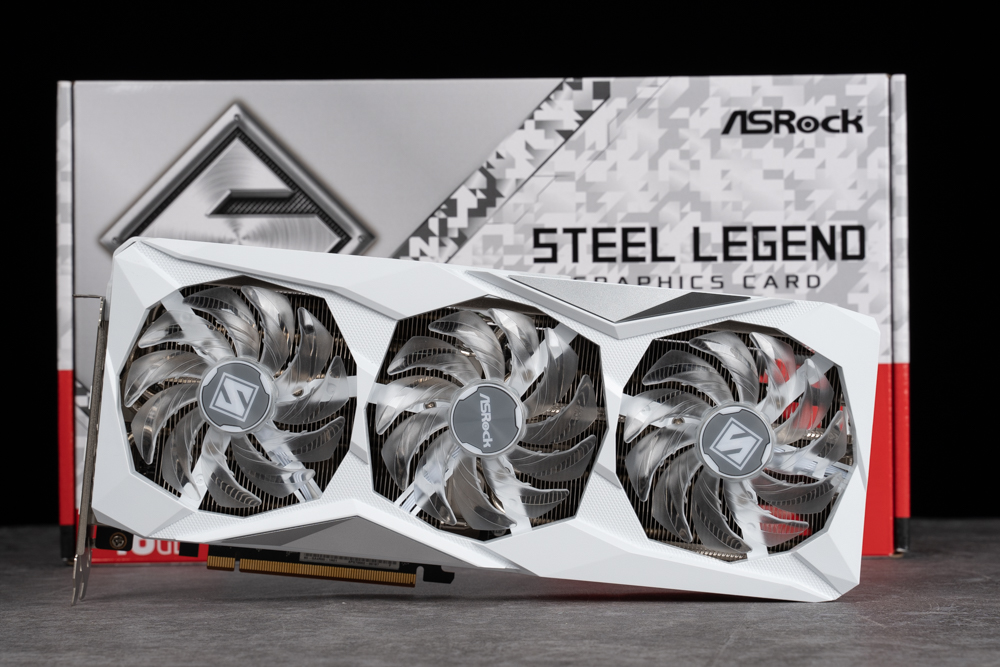
Experience superior gaming with the ASRock Radeon RX 7800, a powerhouse for QHD gaming that prioritizes low noise for an immersive experience. It’s built around the AMD Radeon™ RX 7800 XT GPU, utilizing the cutting-edge Navi 32 architecture. With PCI Express 4.0 x16 support, it’s designed for high-speed data transfer.
Key features include an impressive stream processor count 3840 and a substantial 64MB Infinity Cache. The GPU offers dynamic clock speeds, boasting a boost clock of 2520 MHz and a gaming clock of 2213 MHz. The graphics card has a robust 16GB GDDR6 memory, operates at a swift 19.5 Gbps, and uses a 256-bit memory interface.
In terms of design, the card measures 304 x 131 x 56 mm and occupies 2.8 slots, with a net weight of 1242g. It requires dual PCIe 8-pin connectors and is best paired with an 800W power supply for optimal performance. The card supports DirectX 12 Ultimate and OpenGL 4.6, ensuring compatibility with the latest games and applications.
For connectivity, it includes 1x HDMI 2.1a and 3x DisplayPort 2.1 outputs, allowing up to 4 multi-screen setups. This makes the ASRock Radeon RX 7800 ideal for gamers seeking a blend of power, efficiency, and whisper-quiet operation.
Three fans, metal back panel and reinforced mid-frame | ASRock Radeon RX 7800 XT Steel Legend unboxing
ASRock, traditionally known for its motherboards, has expanded its expertise into the realm of graphics cards, introducing a diverse range of options for both AMD and Intel users. This lineup mirrors the segmentation of its motherboards, offering the premium AQUA and OC Formula series, the reliable Taichi, the Phantom Gaming and Steel Legend series for the mid-range market, and the Challenger series for those entering the graphics card arena. This extensive product range caters to a wide array of users.
The focus of my recent unboxing, the Radeon RX 7800 XT, marks AMD’s latest entry into the QHD gaming graphics card segment. It’s a product that garners significant interest among mainstream gamers, thanks to its balance of performance and affordability. Let’s delve into its capabilities and see what it has to offer.
In a market where larger graphics cards are becoming the norm, the ASRock RX 7800 XT Steel Legend stands out with its medium size, measuring 304mm in length and occupying 2.8 slots. This makes it compatible with most computer cases. Its design is striking, featuring a predominantly white shell complemented by the classic Steel Legend metal back panel, adorned with a stylish gray and white digital camouflage pattern. The branding is prominent, with both the Steel Legend and RADEON logos displayed on the side.
The ASRock RX 7800 series takes a leap forward in terms of connectivity, featuring DP1.4a with enhanced bandwidth. While DP 2.1 monitors are still rare, ASRock’s forward-thinking design ensures compatibility with future technologies.
In summary, the ASRock RX7800 series, especially the RX 7800 XT, stands as a testament to ASRock’s commitment to quality and innovation in the graphics card market, promising a synchronized and forward-looking gaming experience.
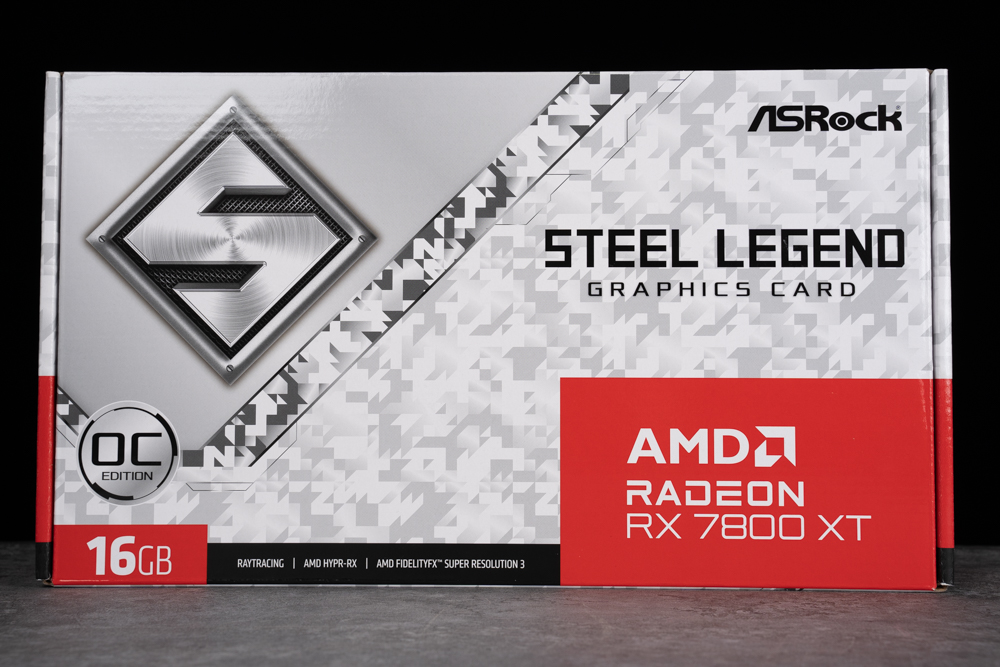
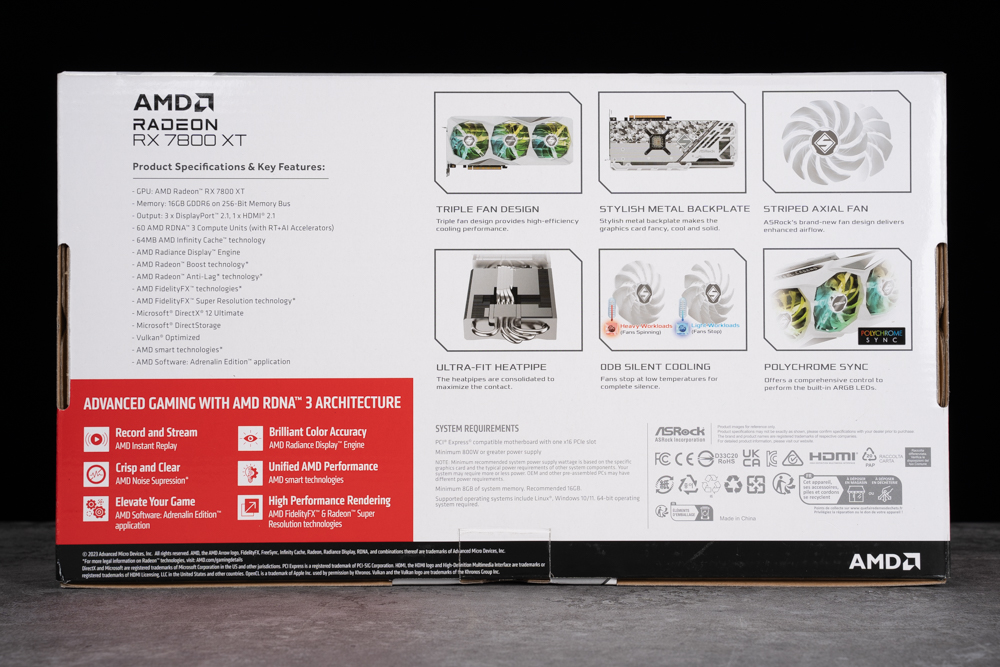
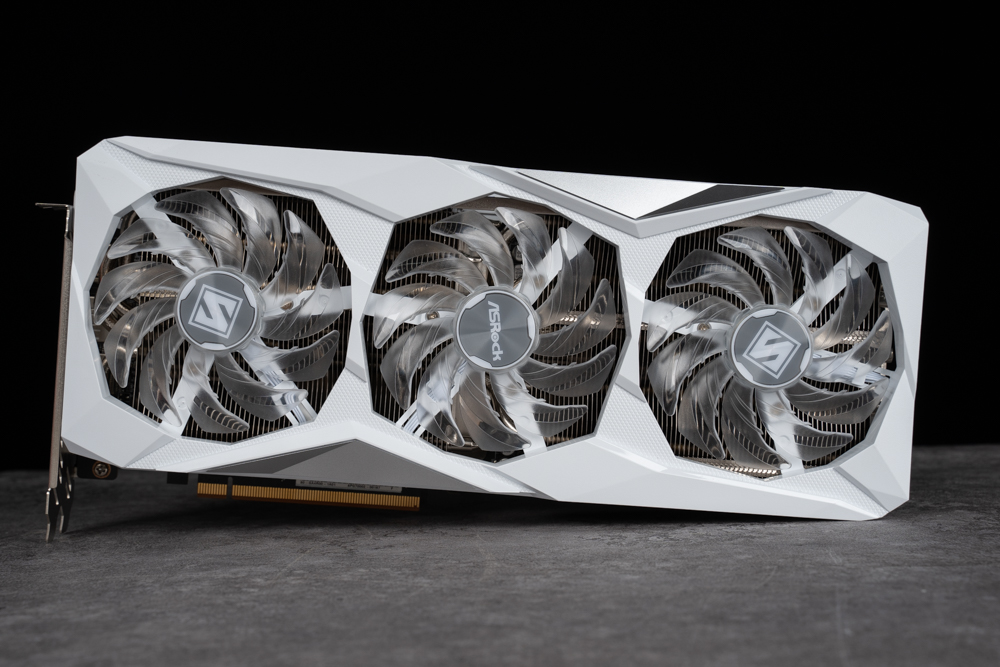
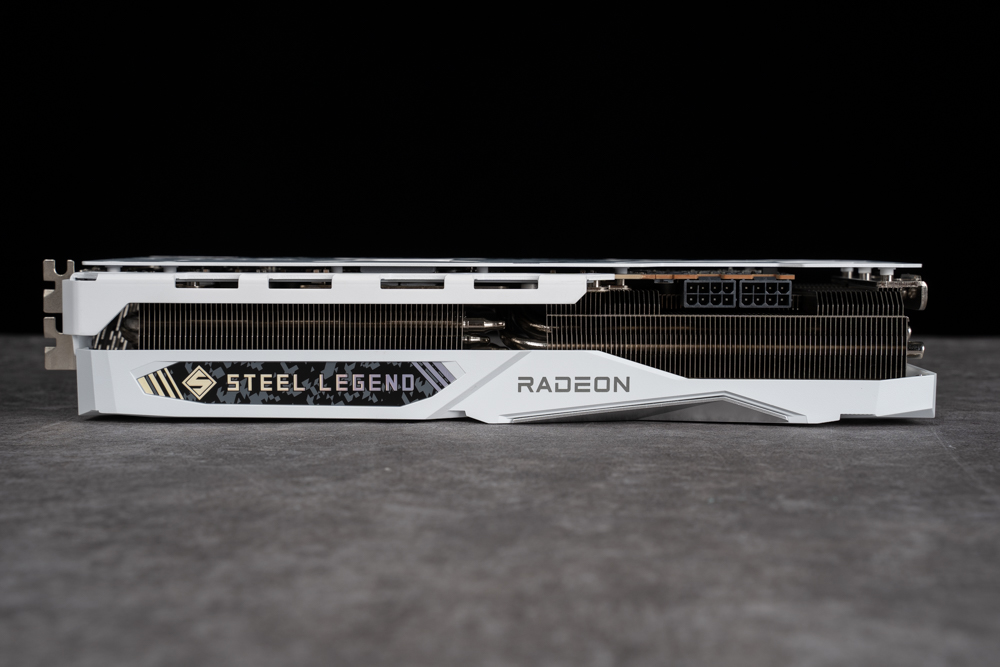
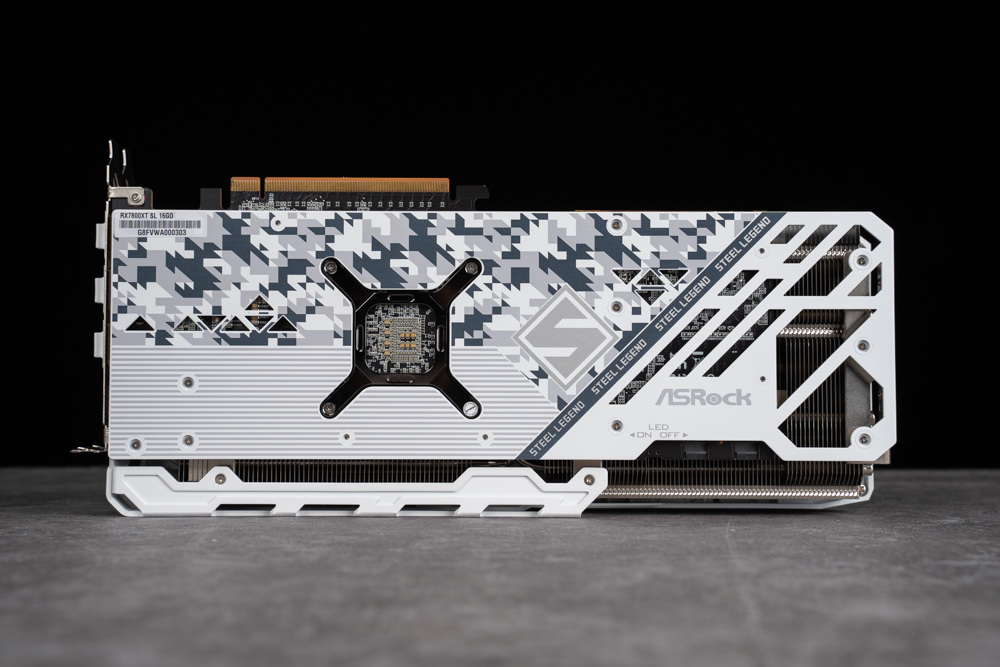
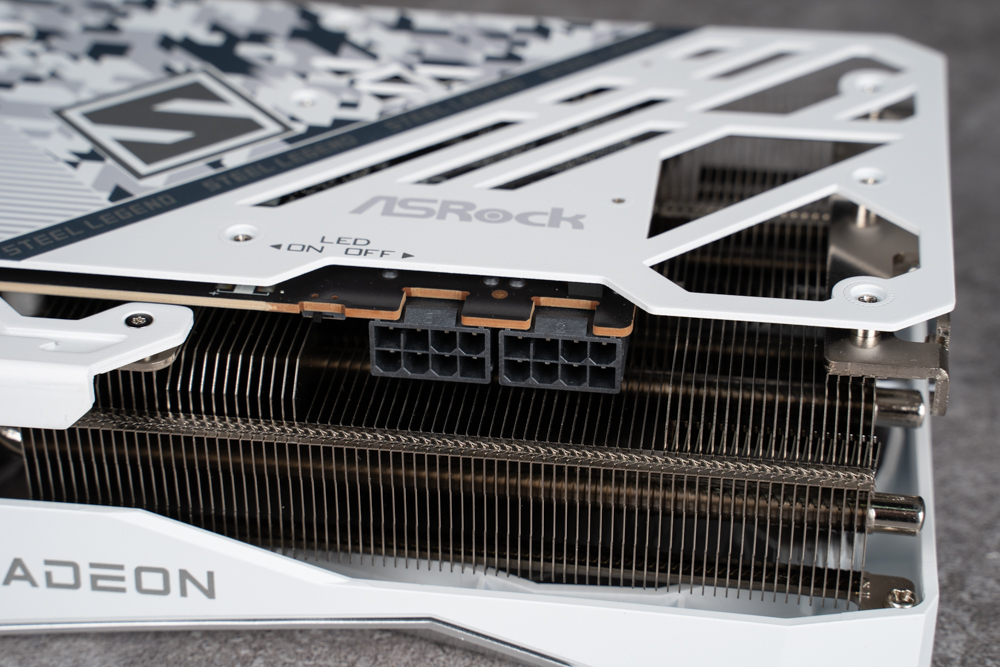
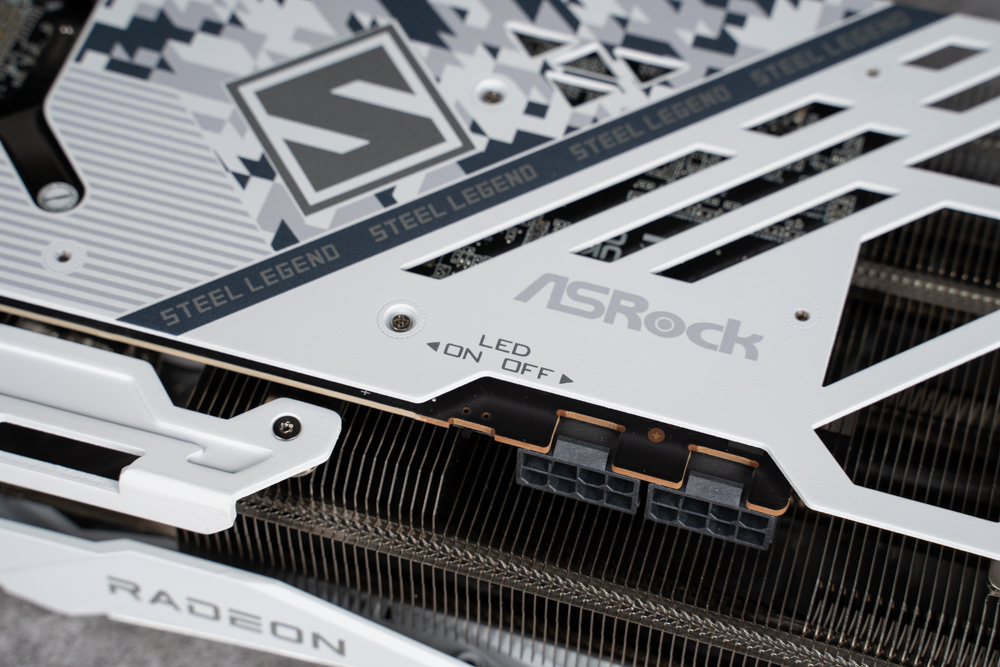
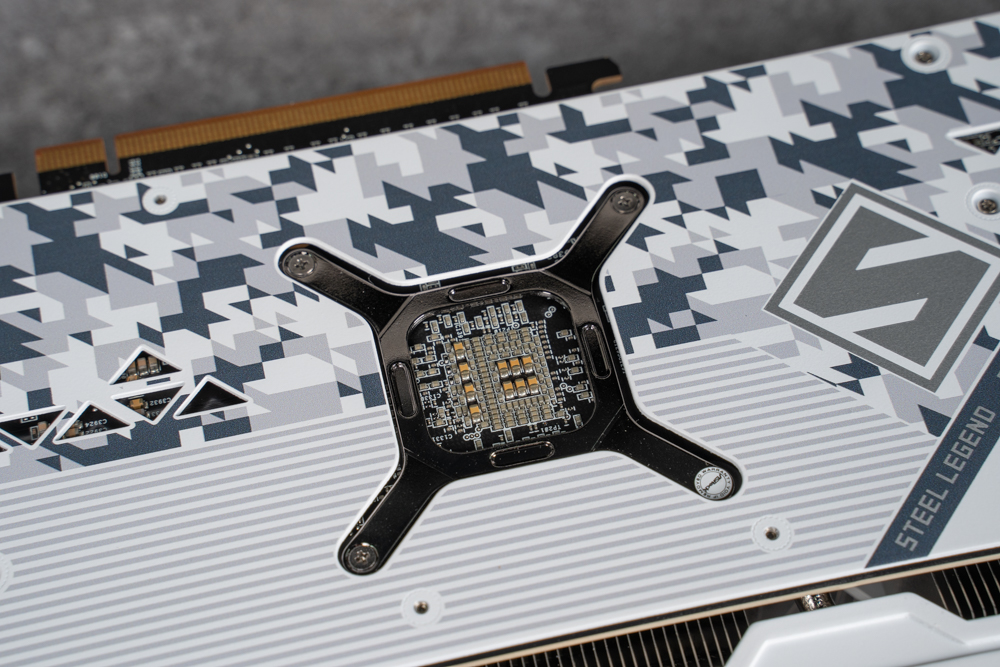
ASRock RX 7800 XT Steel Legend Teardown Analysis
The ASRock Radeon RX 7800 XT Steel Legend 16GB OC is a remarkable graphics card, leveraging the power of AMD’s RDNA 3 architecture and the NAVI 32 core. This advanced GPU is constructed with a blend of cutting-edge technologies, featuring a 5nm GCD (Graphics Compute Die) and four 6nm MCDs (Memory Compute Dies). This hybrid design not only optimizes performance but also enhances energy efficiency.
A standout feature of this graphics card is its integration of second-generation ray tracing accelerators and AI accelerators, providing enhanced realism and smarter, more efficient processing. The card is further bolstered by a substantial 64MB Infinity Cache, distributed as 16MB across each of the four MCDs. This significant cache size plays a crucial role in accelerating data access and improving overall gaming performance.
The ASRock Radeon RX 7800 XT Steel Legend 16GB OC is thus a powerhouse, skillfully combining advanced architecture, ray tracing capabilities, and AI-driven processes to deliver an exceptional gaming experience.
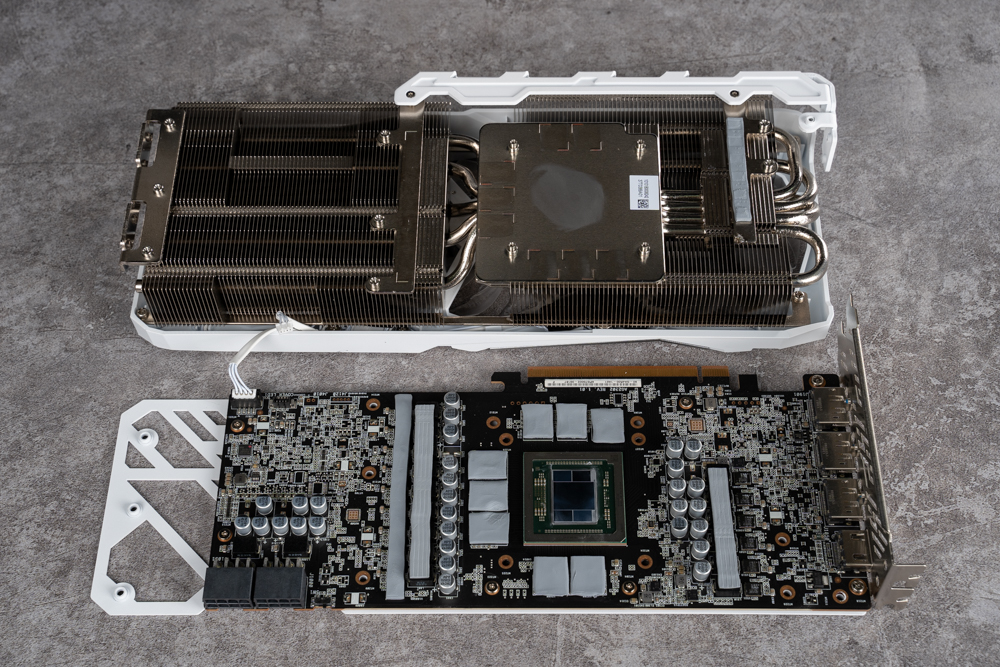
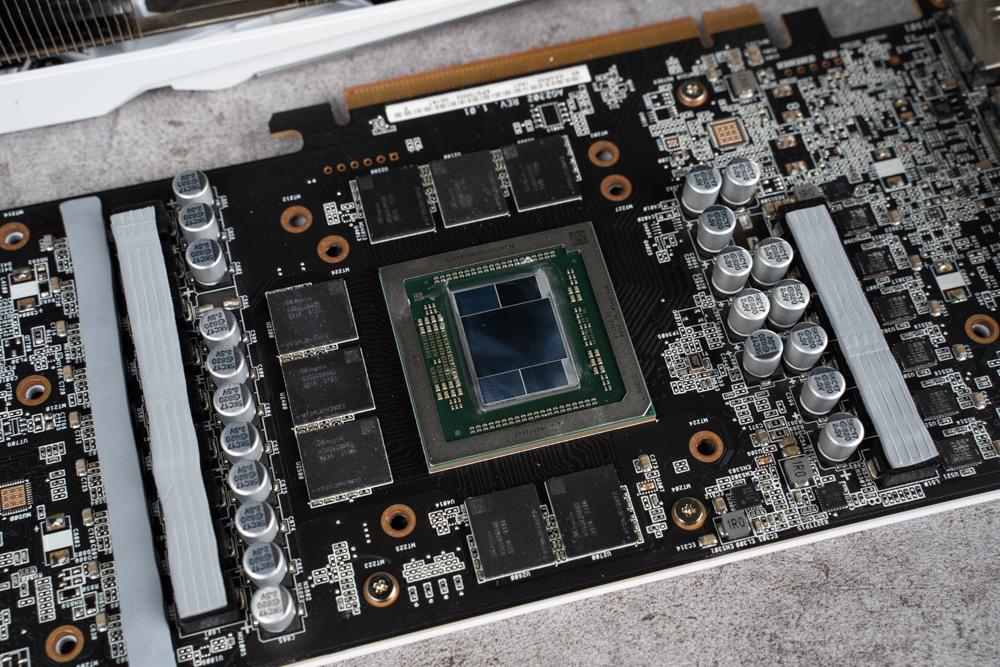
ASRock RX 7800 XT Steel Legend is equipped with 8 2GB GDDR6 display memory for a total of 256-bit, 16GB, manufactured by SK Hynix.
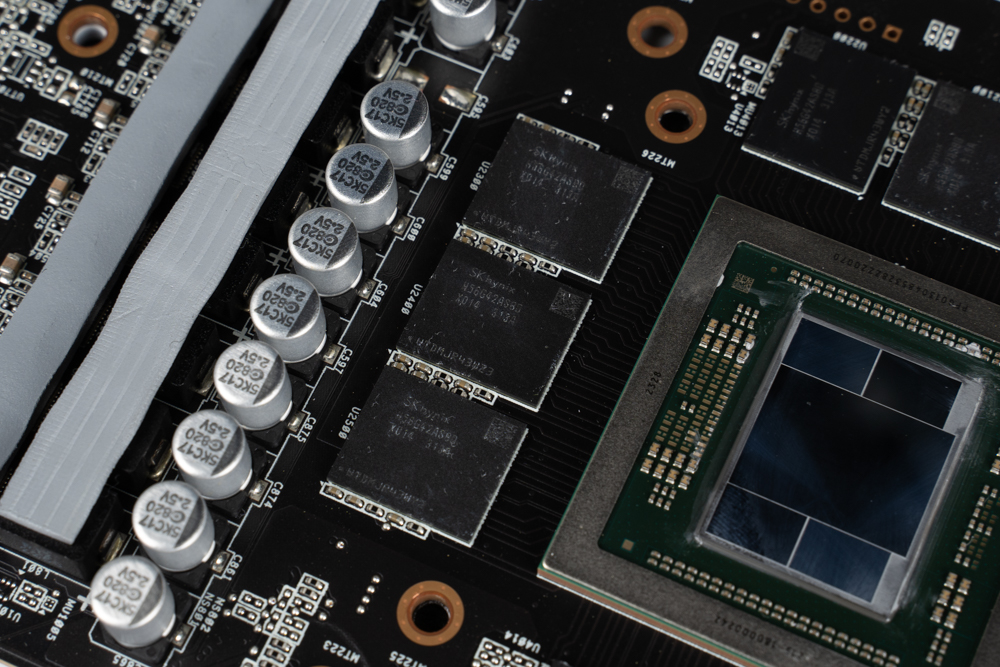
Despite being a relatively recent entrant into the graphics card sector, ASRock has demonstrated a commitment to quality, particularly in the construction of its cooling systems. The company has not cut corners when it comes to the materials used for the radiators on their graphics cards. ASRock employs advanced cooling technologies typically reserved for high-end models, such as super-efficient heat pipes and nickel-plated copper bases. These features are crucial for effective heat dissipation and maintaining optimal performance.
Moreover, ASRock ensures that thermal elements like thermal paste are applied meticulously, covering the heat-generating components evenly. This attention to detail in thermal management is indicative of ASRock’s dedication to delivering reliable and high-performing graphics cards, even as a newer player in the market.
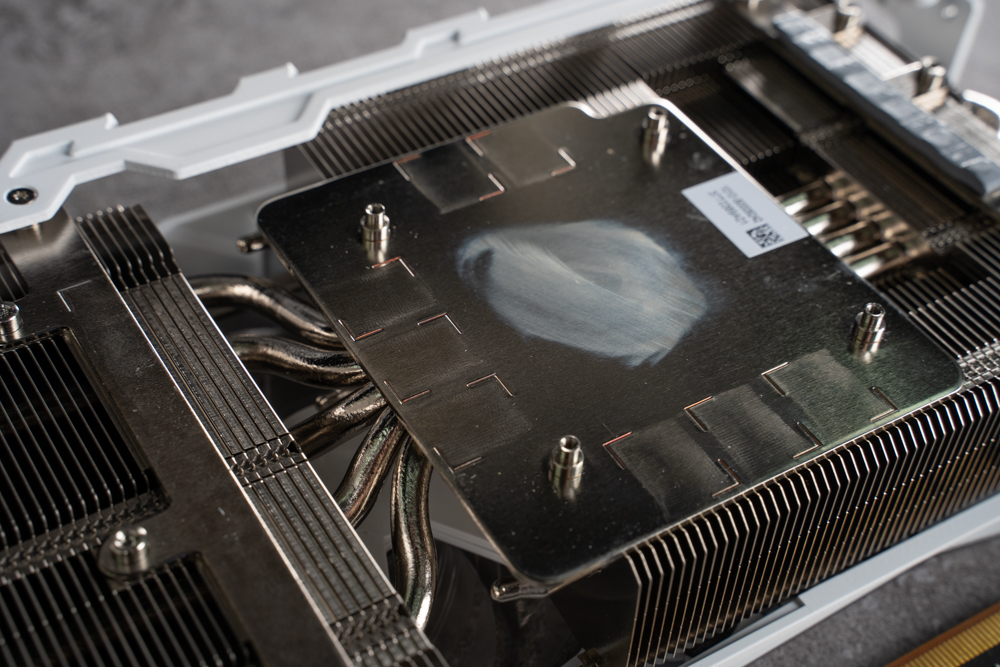
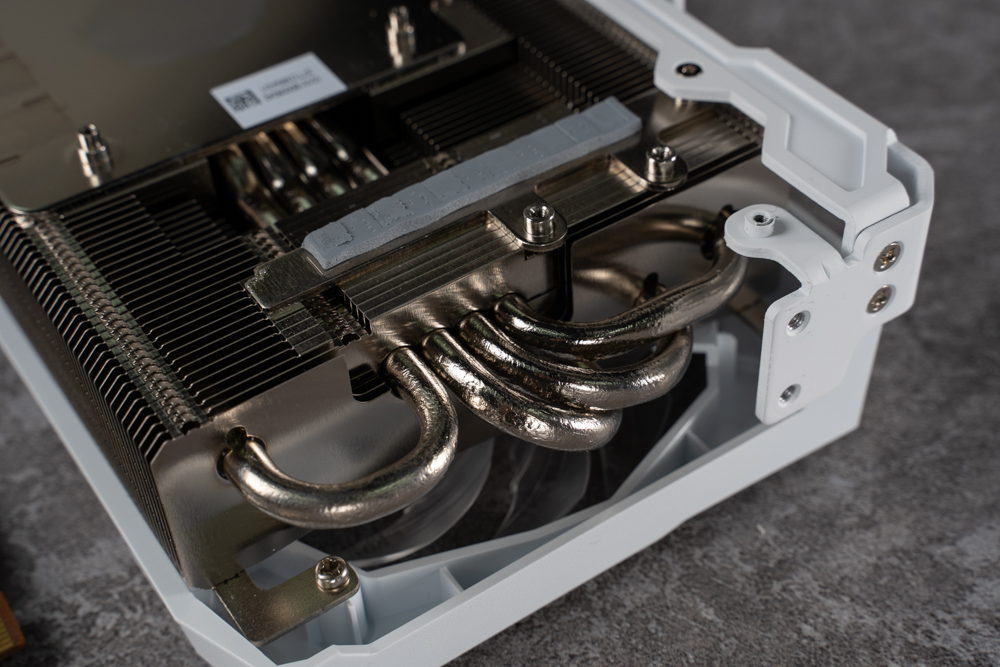
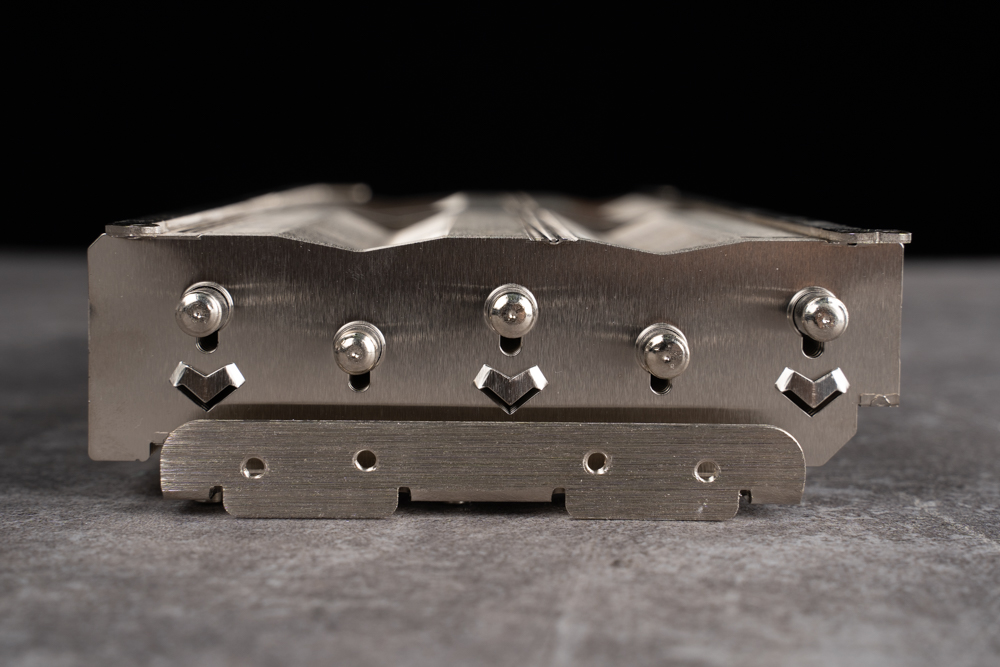
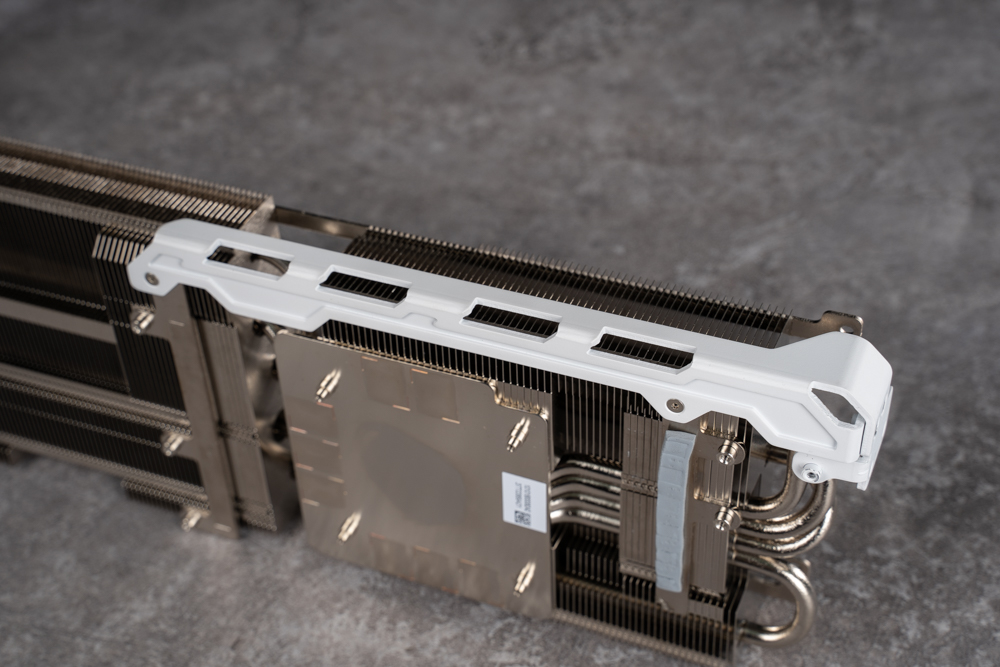
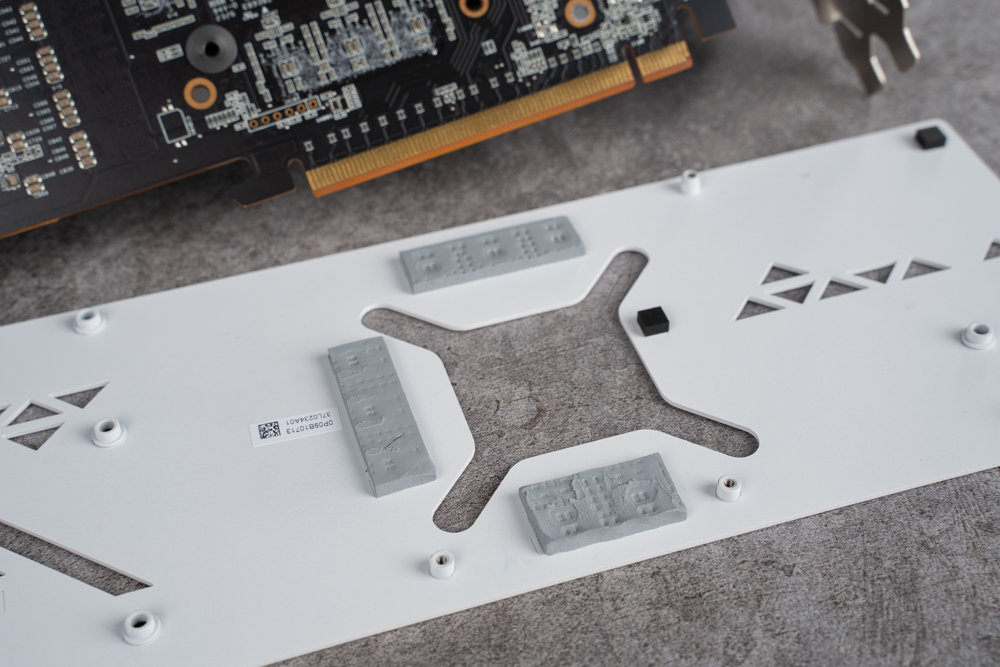
ASRock RX 7800 XT Steel Legend lighting display and ASRock Tweak 2.0 graphics card tool software
The ASRock RX 7800 XT Steel Legend stands out in the gaming hardware market with its innovative fan-bearing design, which includes integrated LED lamp beads. These LEDs are not just for show; they are fully customizable and can synchronize with various lighting effects through ASRock’s Polychrome RGB software. This feature allows users to personalize their gaming setup, offering a vibrant, dynamic lighting experience that enhances the aesthetic of any gaming rig. The inclusion of Polychrome RGB compatibility in the ASRock RX 7800 XT Steel Legend underscores ASRock’s dedication to providing gamers with not only high-performance hardware but also visually compelling components.
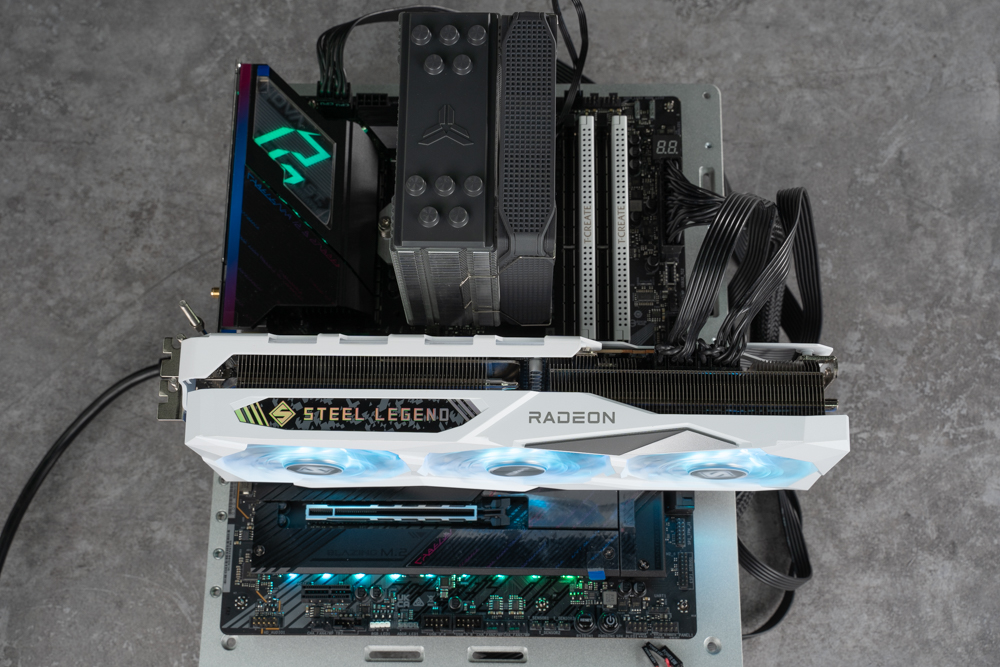
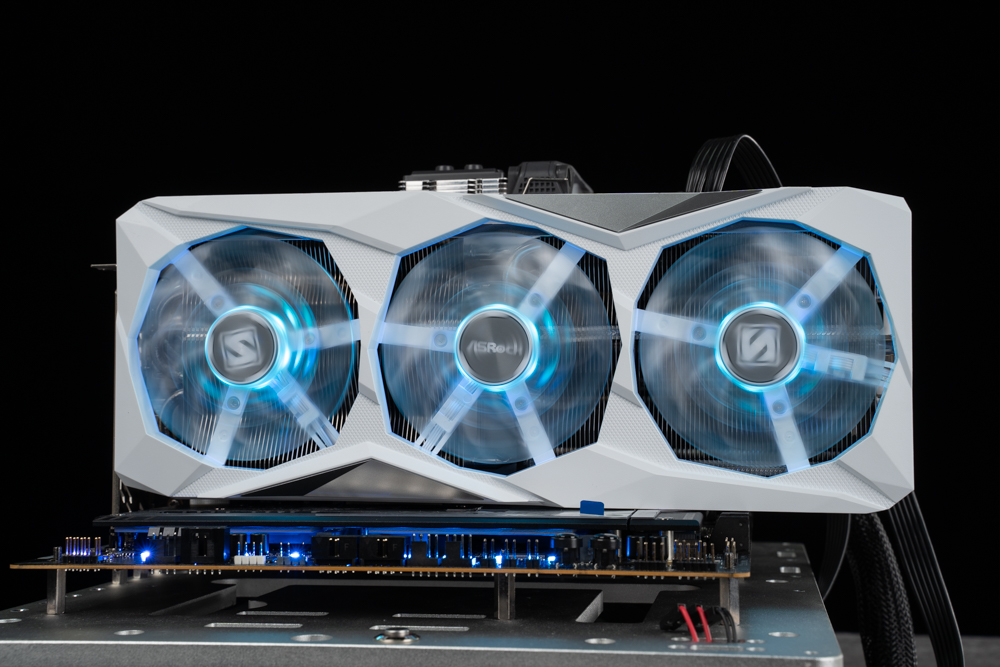
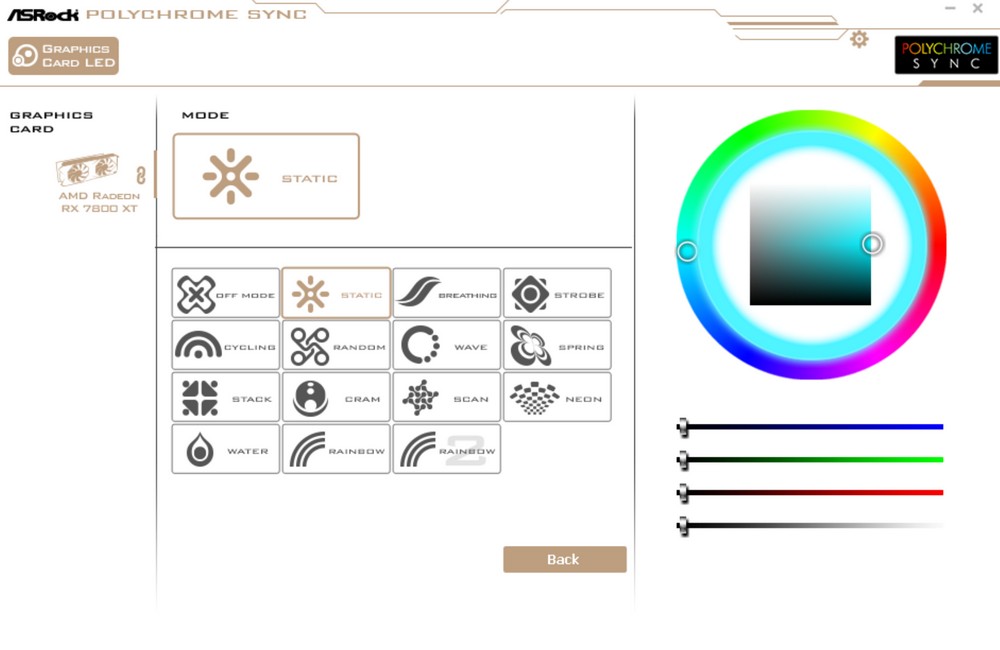
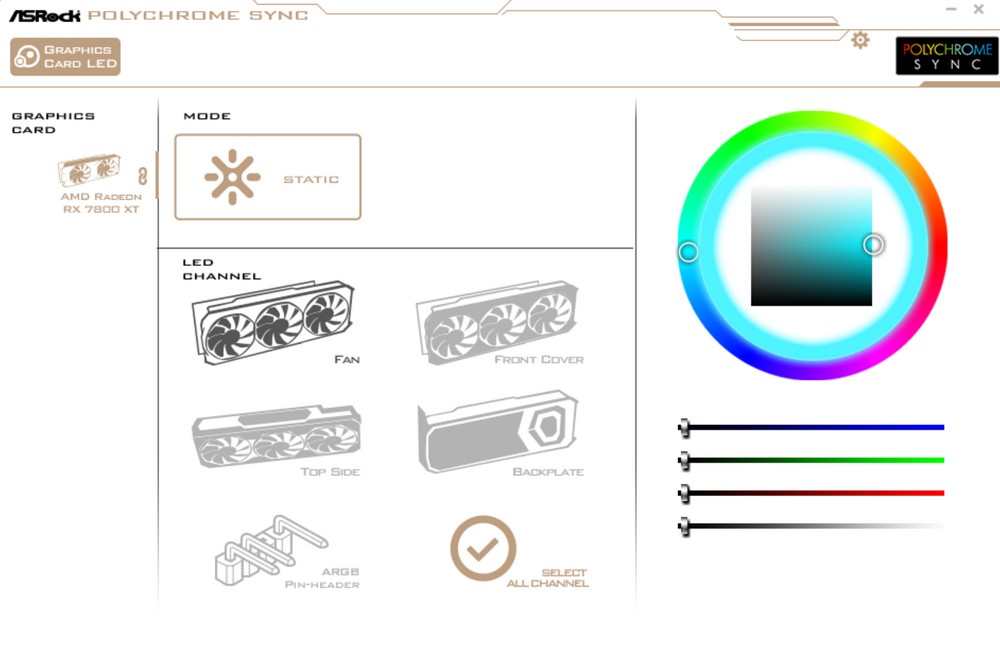
ASRock’s Tweak 2.0 software emerges as a pivotal tool for gamers and PC enthusiasts, offering comprehensive monitoring and control over their graphics card’s performance. This versatile software enables users to keep a close eye on their graphics card’s status, ensuring everything is running smoothly. It provides the flexibility to adjust fan speeds for optimal cooling, manage power consumption limits to balance performance and energy efficiency, and activate overclocking mode to push the graphics card’s capabilities to new heights. With Tweak 2.0, ASRock empowers users to tailor their graphics card’s performance to their specific needs and preferences, making it an essential tool for anyone looking to maximize their gaming or computing experience.
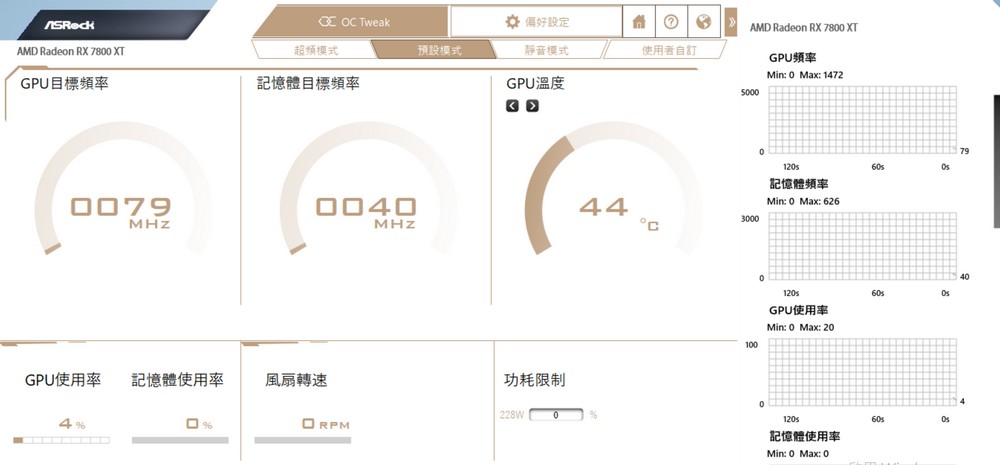
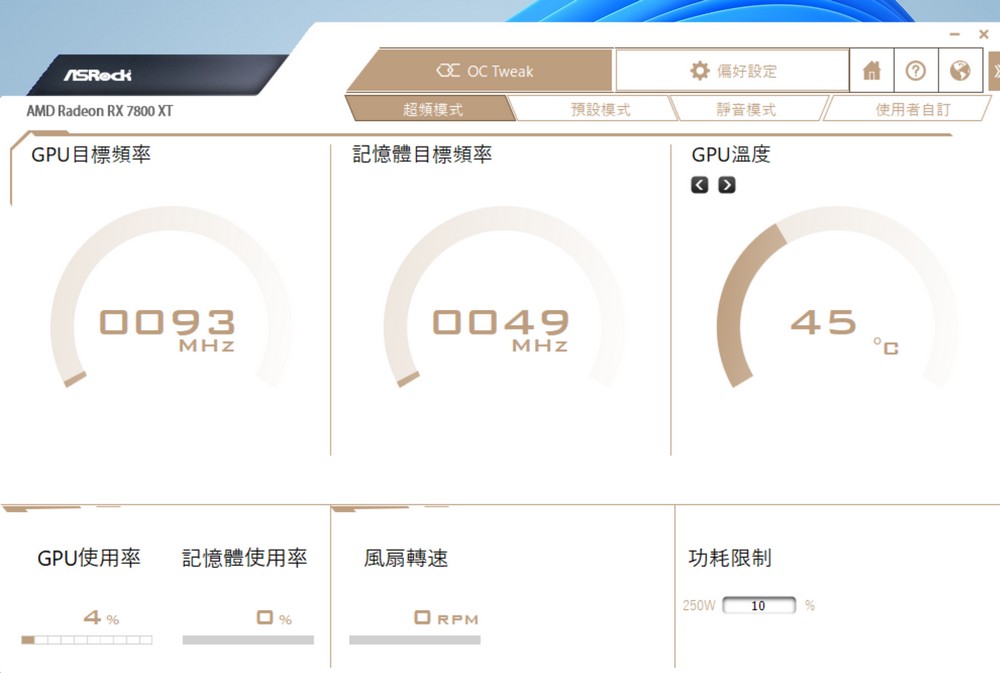
ASRock RX 7800 XT Steel Legend graphics card rendering performance test
For an in-depth performance evaluation, a cutting-edge testing platform was assembled, featuring top-tier components:
- Processor: The Intel Core i9-13900K sits at the heart of the platform, offering high-end processing power.
- Motherboard: ASUS ROG Strix Z790-A GAMING WIFI II, known for its reliability and advanced features.
- Memory: 48GB (24GBx2) of high-speed CORSAIR DOMINATOR TITANIUM DDR5-7200, ensuring swift data processing.
- Graphics Card: The ASRock Radeon RX 7800 XT Steel Legend 16GB OC, with overclocking mode enabled, serves as the centerpiece of this setup.
- Storage Solution: A combination of a CORSAIR MP600 PRO LPX 1TB and a CORSAIR MP400 1TB, the latter dedicated as a game disk.
- Cooling System: The Lianli GALAHAD II LCD 360 radiator, provides efficient cooling.
- Power Supply: A robust Seasonic Focus 1000W, ensuring stable power delivery.
- Operating System: Windows 11 Pro 23H2, offering the latest features and optimizations.
- Driver Version: Adrenaline 23.10.2, ensuring the graphics card runs with the latest software support.
Utilizing GPU-Z for insights, the RX 7800 XT’s capabilities were closely examined. It features the NAVI 32 core, a 256-bit GDDR6 with a substantial 16384MB of display memory, a base frequency of 2213 MHz, and a boost frequency of 2520MHz. It operates on a PCIe 4.0 x 16 interface, showcasing its high bandwidth and fast data transfer capabilities.
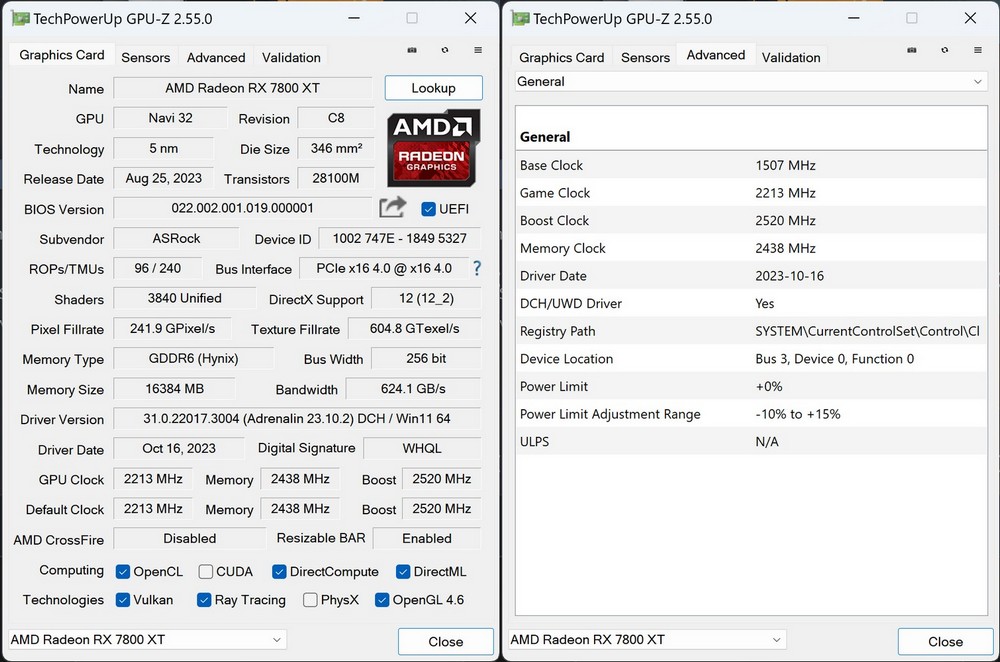
Indigo Bench, a free and versatile testing software, is built upon the advanced Indigo 4 rendering engine. This tool stands out for its compatibility with a wide range of graphics cards, supporting those from AMD, NVIDIA, and Intel, thanks to its reliance on the OpenCL architecture. Indigo Bench offers two distinct rendering performance tests, featuring a bedroom scene and a sports car model. The performance is measured in rendering units per second, where higher scores indicate better rendering efficiency.
In this rigorous testing environment, the ASRock RX 7800 XT Steel Legend demonstrated its formidable capabilities. In the bedroom scene, it achieved an impressive 13.809 samples per second. The graphics card’s prowess was further evident in the sports car scene, where it scored an outstanding 31.057 samples per second. These results highlight the ASRock RX 7800 XT Steel Legend’s exceptional rendering performance, making it a top contender in its class.
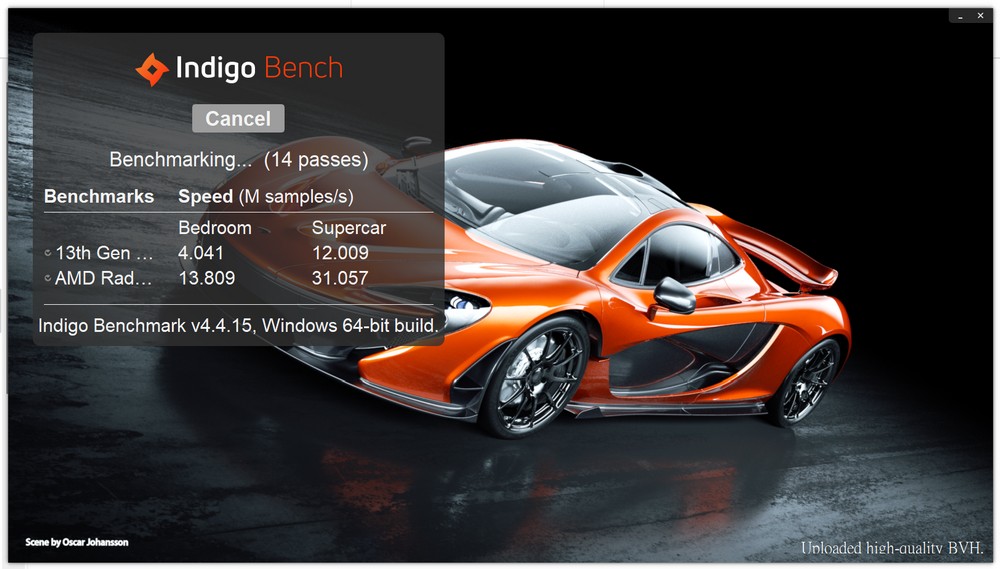
The Blender benchmark launcher, a complimentary benchmark testing tool, is offered by Blender, the renowned 3D drawing software. This tool is unique in its provision of three distinct benchmarking projects: ‘Monster’, ‘Junkshop’, and ‘Classroom’. These tests offer users the flexibility to choose between testing their CPU or GPU to gauge performance. In a demonstration of its robust capabilities, the ASRock RX 7800 XT Steel Legend graphics card was put through these tests and yielded impressive scores. It achieved a score of 1220 in ‘Monster’, 655 in ‘Junkshop’, and 584 in ‘Classroom’. These results underline the ASRock RX 7800 XT Steel Legend’s proficiency in handling demanding 3D rendering tasks, making it a standout choice for both gaming and professional graphics work.
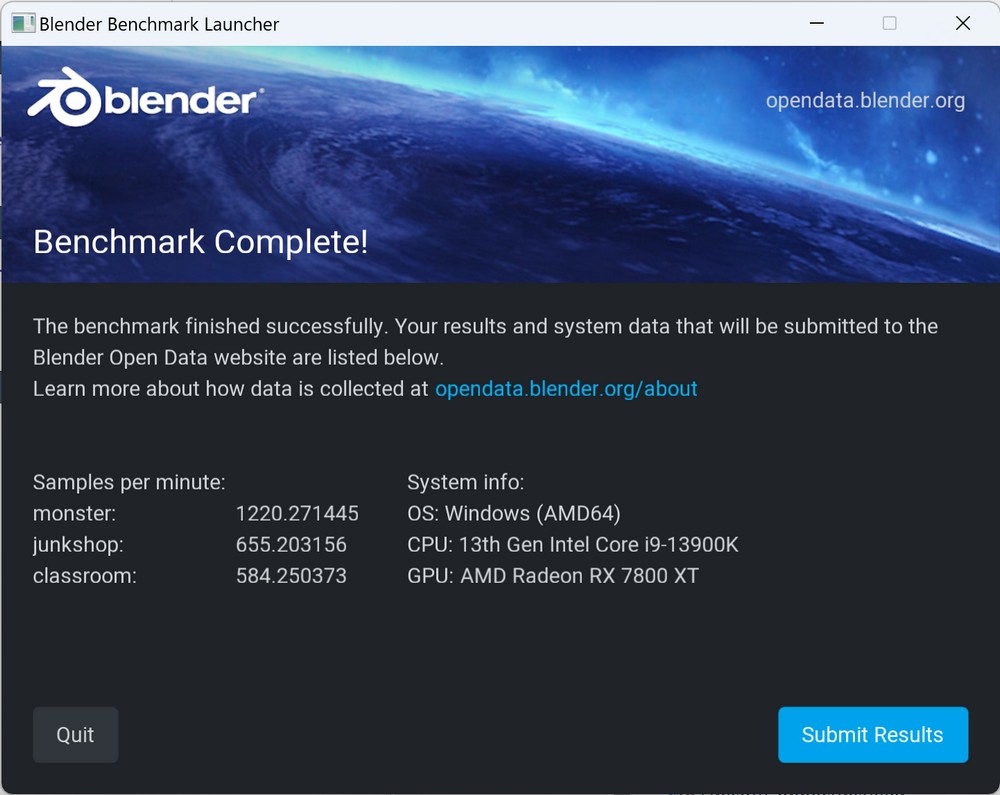
SPECviewperf 2020 stands as a comprehensive benchmarking solution, specifically designed for evaluating performance using various professional 3D modeling software. This tool encompasses eight distinct projects, each tailored to assess different aspects of graphical performance. The projects include Energy, Medical, Catia, Creo, Maya, SNX, and SolidWorks, all utilizing the OpenCL architecture for testing. There’s a project for 3ds Max, which is tested using the DirectX framework.
A key aspect of SPECviewperf 2020 is its testing at an ultra-high image quality of 3800×2120, ensuring that the benchmarking is conducted under demanding visual conditions. This high-resolution testing is crucial for accurately gauging the capabilities of graphics hardware in handling intricate and resource-intensive 3D tasks, making SPECviewperf 2020 an essential tool for professionals seeking to evaluate the performance of their systems in real-world, graphics-intensive applications.
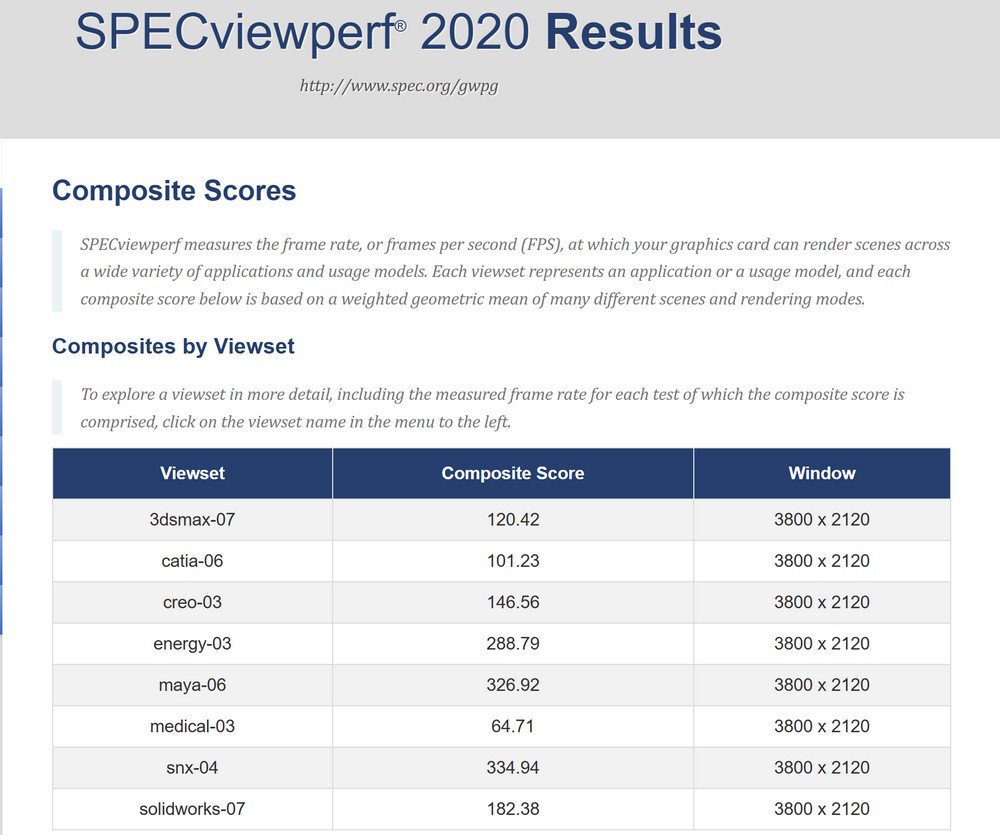
Geekbench 6, the latest iteration of the renowned benchmarking tool, offers a more nuanced approach to assessing graphics card performance, especially in professional applications. This advanced benchmark evaluates a graphics card’s capabilities through a variety of challenging scenarios. It encompasses a wide array of tests that mirror real-world tasks, making it an indispensable tool for evaluating the proficiency of graphics cards in demanding contexts like image processing, rendering, and machine learning.
The benchmark now includes updated, real-world test scenarios, enhancing its relevance to modern computational devices. This includes tasks such as blurring backgrounds in video conferencing, filtering and adjusting images for social media, and using machine learning models for photo tagging. Geekbench 6 has refined its approach to multi-core handling, emphasizing core cooperation in shared tasks, which provides a more realistic measure of heterogeneous core performance. This is particularly pertinent given the trend towards incorporating both “performance” and “efficient” cores in computing devices.
In this context, the ASRock RX 7800 XT Steel Legend has shown remarkable results. When tested under Geekbench 6, its performance in both OpenCL and Vulkan APIs indicates its robust capability in handling diverse and complex professional tasks. The scores achieved by this graphics card in Geekbench 6 are a testament to its suitability for users who require a potent and versatile graphics solution, capable of excelling in a variety of high-demand scenarios.
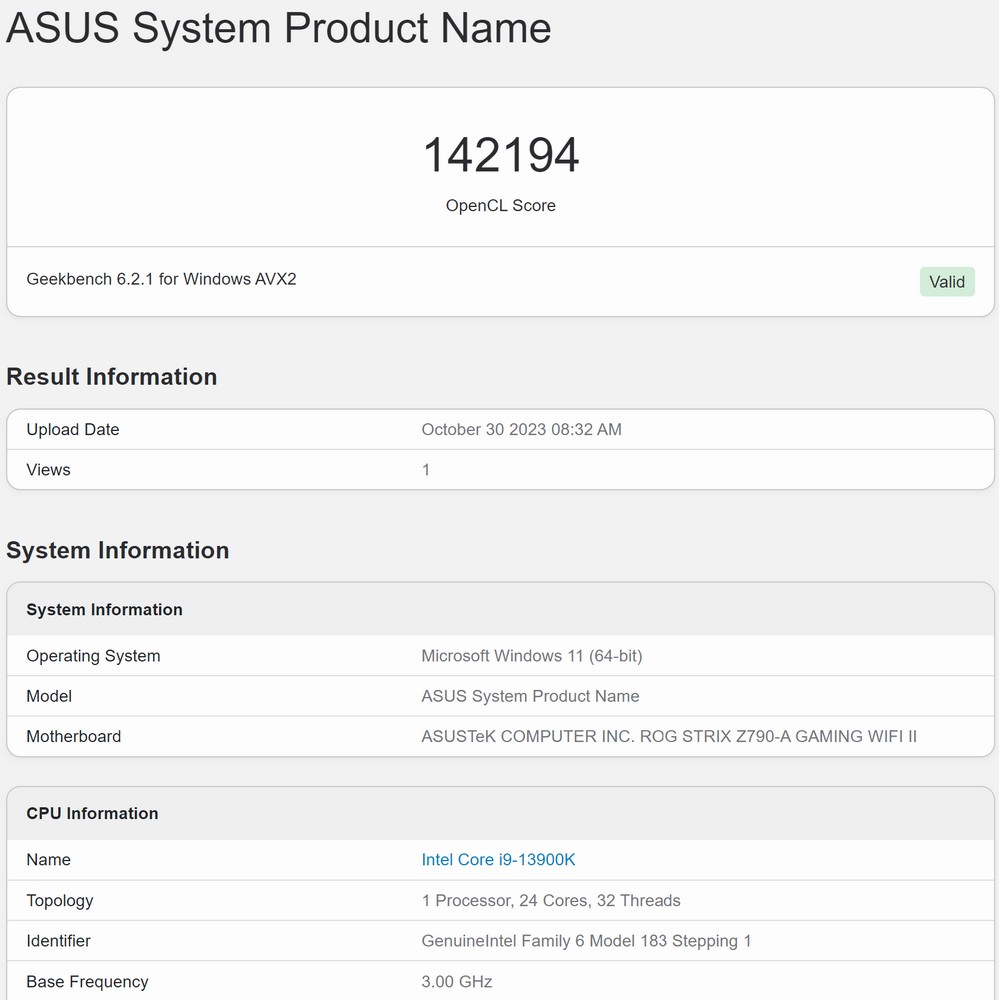
ASRock Radeon RX 7800 XT Steel Legend 16GB OC 3DMARK Benchmark Test
3DMark, a well-regarded benchmarking software for gaming performance, is known for its comprehensive coverage of various APIs, image qualities, and specialized features like ray tracing and FSR (FidelityFX Super Resolution) functions. Notably, 3DMark Fire Strike, which utilizes the DirectX 11 API, conducts tests across three key areas: CPU, GPU, and a combined CPU/GPU test. These tests are performed at different resolutions: 1080P, 2K (labeled as Fire Strike Extreme), and 4K (Fire Strike Ultra).
In the context of the ASRock RX 7800 XT Steel Legend, its performance metrics in these tests are quite impressive. Specifically, in the Fire Strike benchmark at 1080P, the graphics performance score achieved is 49,780 points. In Fire Strike Extreme at 2K, the score is 25,267 points, and in Fire Strike Ultra at 4K, it records a score of 12,516 points.
3DMark has been continuously updated to support new hardware and drivers, ensuring it remains relevant and effective for modern benchmarking needs. Regular updates have been a hallmark of 3DMark, with significant new benchmarks, tests, and features added each year. Some of these updates are available for free, even in the Basic Edition and the 3DMark Demo on Steam, while others, like major releases such as Port Royal and Speed Way, are available as paid upgrades. Certain tests, like the 3DMark Storage Benchmark, are released as DLC, purchasable separately by all users.
The software’s version number changes frequently with the addition of new features and updates to maintain compatibility with the latest hardware. It’s advisable to use the latest version of 3DMark for the most accurate benchmarking results. The most recent updates, as of November 2023, include fixes and improvements to the 3DMark Storage Benchmark, Port Royal, and Speed Way tests.
For comprehensive and up-to-date information on 3DMark and its various benchmarks, please visit their official website or the support pages for detailed release notes and updates.
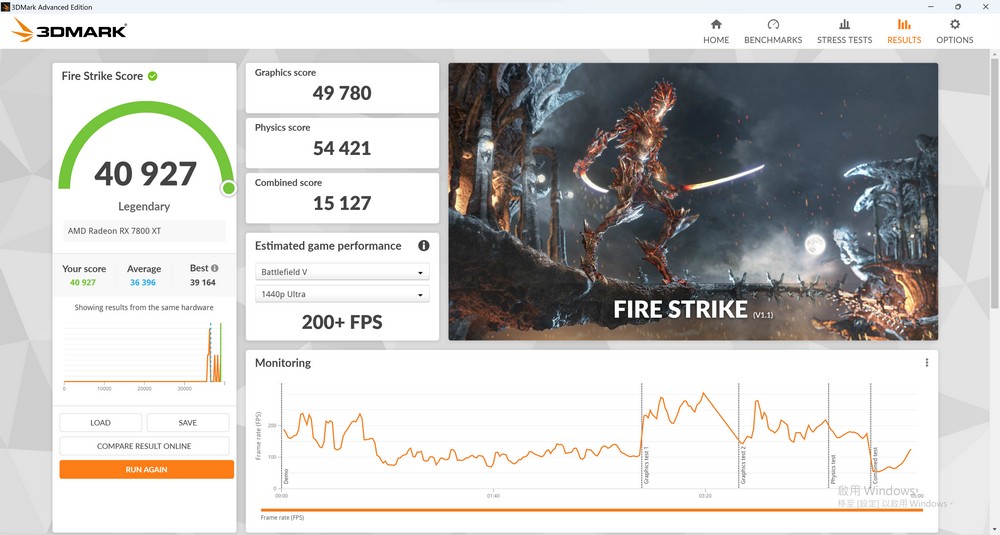
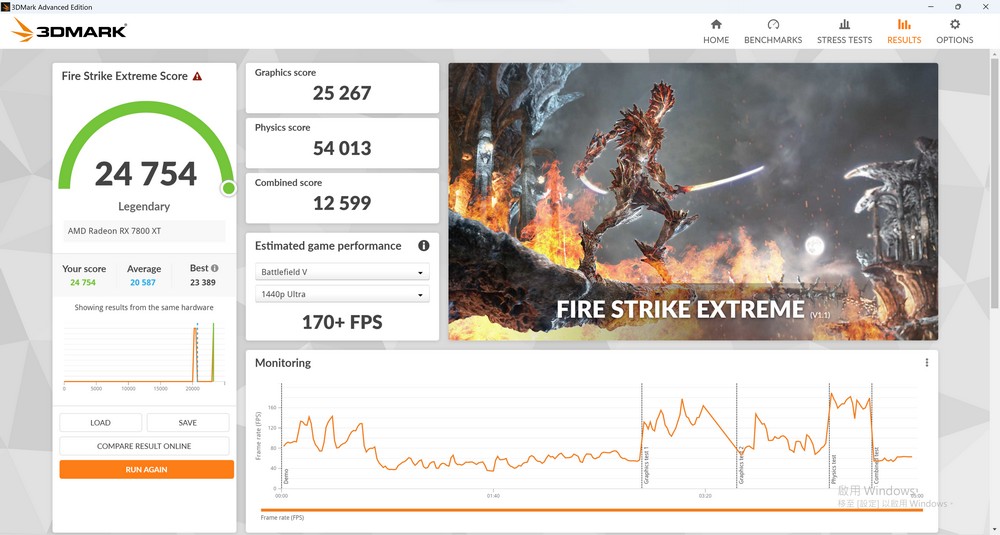
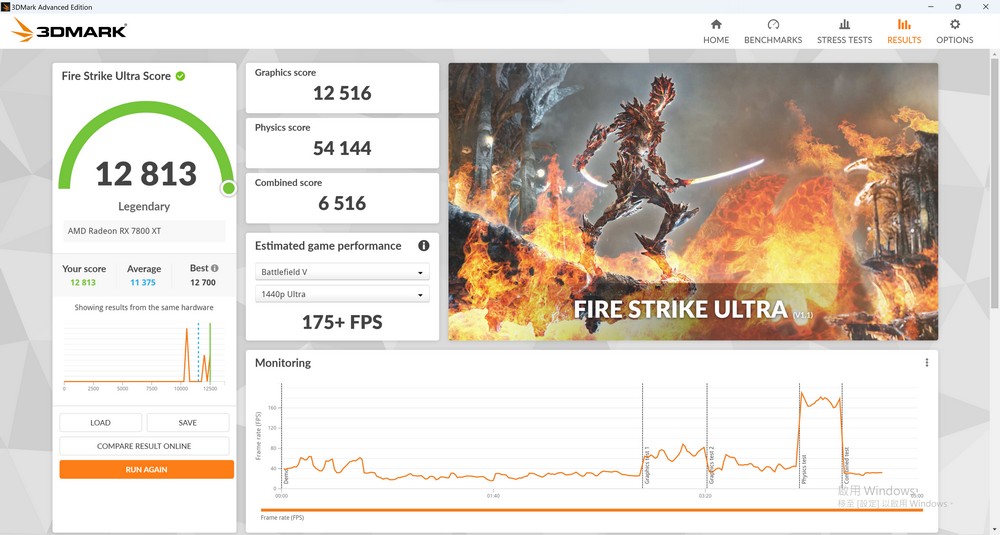
3DMark’s Time Spy and Time Spy Extreme are specialized tests within the 3DMark suite, designed to evaluate the performance of graphics hardware using the DirectX 12 API. Time Spy operates at a 2K resolution, while Time Spy Extreme pushes the hardware further with 4K image quality testing. These tests provide valuable insights into how a graphics card will perform under the demands of modern DirectX 12 games.
For the ASRock RX 7800 XT Steel Legend, the performance in these tests is noteworthy. The Time Spy test, with its 2K resolution, yields a graphics score of 19,484 points. This score is indicative of the card’s ability to handle high-resolution gaming with complex DirectX 12 features. The more demanding Time Spy Extreme test, which assesses 4K performance, gives the card a score of 9,213 points. This score, although lower due to the increased demands of 4K rendering, still reflects a strong performance in handling extremely high-resolution graphics.
These scores are a testament to the ASRock RX 7800 XT Steel Legend’s capabilities in handling modern gaming requirements, especially in terms of high-resolution and DirectX 12 graphics rendering. It’s important to note that these benchmark scores can vary based on system configurations, driver versions, and other factors. For the most accurate assessment, it’s recommended to use the latest version of 3DMark and to compare scores from similar system setups.
For detailed information on the latest updates to 3DMark and how they may affect scores, especially for DirectX 12 tests like Time Spy and Time Spy Extreme, you can refer to the official 3DMark release notes and support pages. These resources provide comprehensive details on the benchmark’s features, updates, and how to interpret the scores in the context of your hardware and software environment.
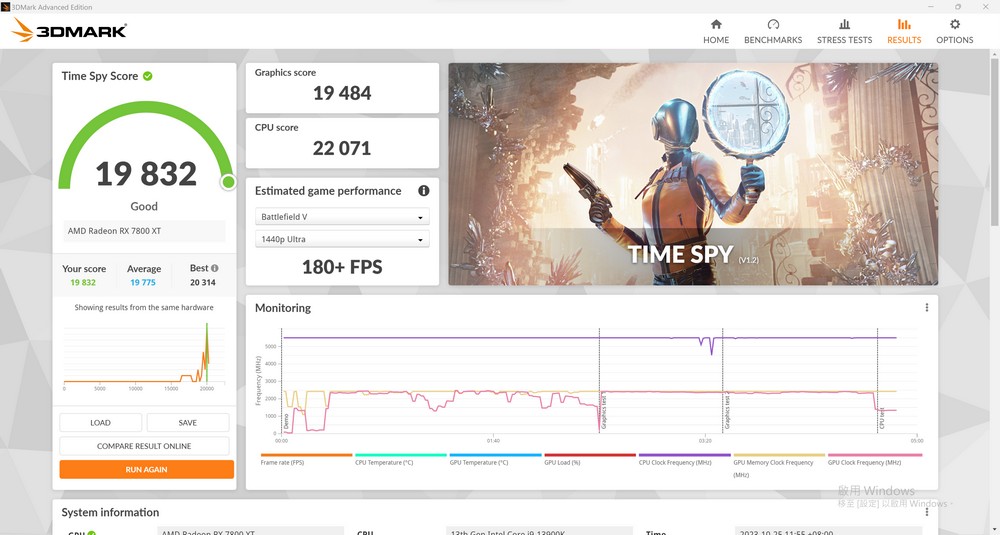
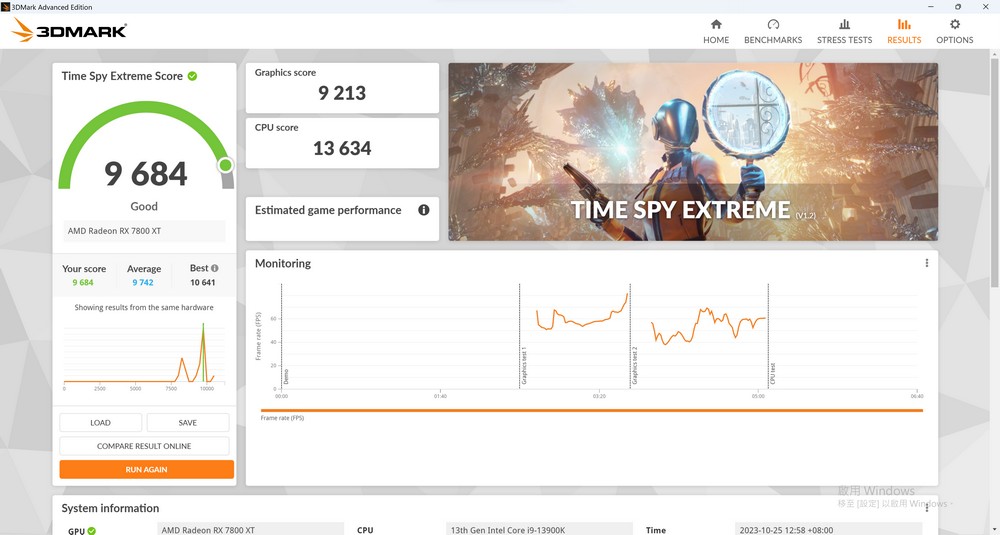
The 3DMark Port Royal benchmark is a specialized test within the 3DMark suite that focuses on evaluating the performance of graphics hardware using the DirectX 12 DXR API for real-time ray tracing. It operates at a 2K resolution, providing a stringent test for how well a graphics card can handle advanced lighting and reflection effects that are characteristic of ray tracing technology.
For the ASRock RX 7800 XT Steel Legend, achieving a score of 10,525 points in the Port Royal benchmark is an impressive feat. This score indicates that the graphics card is highly capable of handling real-time ray tracing at 2K resolution, a demanding task that puts a significant load on a GPU. The ability to perform well in the Port Royal benchmark suggests that the ASRock RX 7800 XT Steel Legend is well-suited for the latest games that utilize DirectX Raytracing, offering a high level of visual realism and detail.
It’s important to remember that these benchmark scores can be influenced by various factors including system configuration, driver versions, and the specific version of the benchmarking software used. To ensure accurate comparisons, it is advisable to use the latest version of 3DMark and to understand the context of the hardware configuration in which the benchmark was run.
For the most up-to-date information on 3DMark’s Port Royal benchmark, including details on how it assesses DirectX Raytracing performance and the latest updates to the test, please refer to the official 3DMark release notes and support pages. These resources offer comprehensive insights into the benchmark’s methodologies and how to interpret scores relative to different hardware setups.
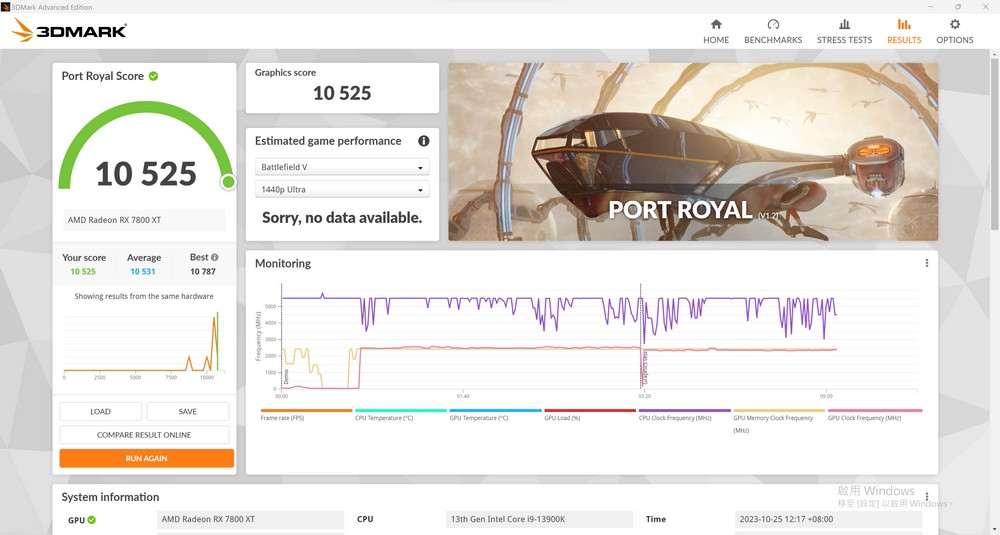
3DMark’s Speed Way benchmark is a cutting-edge test that leverages the capabilities of the DirectX 12 Ultimate API, showcasing advanced graphics technologies such as real-time ray tracing global lighting and reflections, as well as Mesh Shader technology. This benchmark is designed to provide gamers with a reference for the latest in ray tracing game performance.
The ASRock RX 7800 XT Steel Legend scoring 3843 points in the Speed Way benchmark is a notable achievement. This score reflects the GPU’s capability to handle the complex and computationally intensive demands of DirectX 12 Ultimate’s advanced features, including real-time ray tracing at tier 1.1. The performance in this benchmark is indicative of the graphics card’s ability to deliver high-quality visuals in the latest games that utilize these cutting-edge technologies.
The Speed Way benchmark is particularly significant as it represents the forefront of current gaming graphics technology, pushing the limits of what modern GPUs can achieve in terms of visual fidelity and realism. The ASRock RX 7800 XT Steel Legend’s performance in this benchmark suggests that it is well-equipped to handle the most graphically demanding games and applications currently available.
For detailed information on the Speed Way benchmark, including its features, testing methodologies, and the latest updates, you can refer to the official 3DMark release notes and support pages. These resources offer comprehensive insights into the benchmark’s capabilities and how to interpret scores about different hardware configurations.
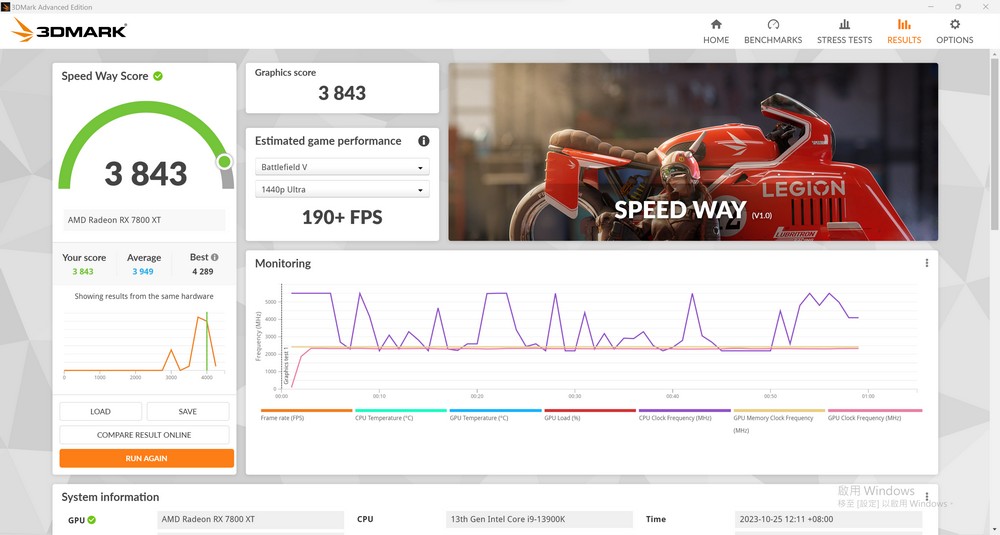
The AMD FSR (FidelityFX Super Resolution) feature test in 3DMark is designed to evaluate the performance enhancement capabilities of AMD’s FSR2 technology. This test uses the Speed Way benchmark, with ray tracing turned off, as a base to assess frame rate improvements at different resolutions (2K and 4K) and under various FSR2 modes (not turned on, quality, balance, performance, and ultra-performance).
The results of this test highlight the significant impact of FSR2 technology on frame rates. Even when FSR2 is set to its lowest quality mode, there’s a notable doubling of frame rates, with even greater improvements observed in the super performance mode. This indicates that FSR2 can effectively boost gaming performance, especially in terms of frame rate, which is crucial for a smoother gaming experience.
However, it’s important to note that the effectiveness of FSR2 can vary depending on the game’s own optimization. For instance, in a game like “Forza Horizon 5,” the difference in frame rates with FSR2 enabled might be minimal, ranging only between 1 to 3 frames. This suggests that while FSR2 has the potential to significantly enhance performance, its actual impact can depend heavily on how well it’s integrated and optimized within individual games.
This variability underscores the importance of game-specific optimization for technologies like AMD FSR2. The technology’s ability to improve gaming performance isn’t just about its inherent capabilities, but also how well it’s adapted to the unique demands and characteristics of each game. For gamers, this means that while FSR2 can offer substantial benefits, the actual experience may differ from one game to another.
For more detailed insights into the AMD FSR feature test and its implications for gaming performance, it’s advisable to refer to specialized gaming hardware reviews and benchmarks that provide in-depth analysis of these technologies in various gaming scenarios.
ASRock Radeon RX 7800 XT 9 games tested
The ASRock RX 7800 XT Steel Legend, positioned as a 2K gaming card, shows commendable performance in both 2K and 4K resolutions across a variety of demanding games. This test, which includes popular and graphically intensive games such as “Starfield,” “Call of Duty: Modern Warfare II,” “Watch Dogs: Legion,” “Rainbow Six: Siege,” “Rainbow Six Extraction,” “Assassin’s Creed Valhalla,” “Horizon Zero Dawn,” “God of War,” and “Shadow of the Tomb Raider,” provides a broad spectrum to evaluate the card’s capabilities.
At 2K resolution, the ASRock RX 7800 XT Steel Legend is able to match the high demands of a 144Hz screen refresh rate for most of these test games, demonstrating its proficiency in handling high-resolution gaming with demanding graphical settings. This level of performance ensures a smooth and visually rich gaming experience, particularly for players who prioritize high frame rates and detailed graphics.
When the resolution is increased to 4K, the card still manages to deliver smooth gameplay in most of these games, nearly reaching 100 frames per second. This is an impressive feat, considering the increased graphical demands at 4K resolution. However, it’s noted that adjusting screen effects can further enhance the gaming experience, suggesting that finding the right balance between graphical fidelity and performance is key to optimizing the gaming experience at 4K.
The use of AMD’s FSR (FidelityFX Super Resolution) technology in either balance or quality modes in these tests demonstrates the card’s ability to maintain high performance while also delivering quality visuals. FSR technology helps to boost frame rates without significantly compromising the visual quality, making it a valuable feature for gamers looking to maximize their gaming experience.
Overall, the ASRock RX 7800 XT Steel Legend shows itself to be a strong contender for gamers who are looking for a card that can handle the latest games at high resolutions and frame rates, offering a balance between performance and visual fidelity. For detailed reviews and performance benchmarks of the ASRock RX 7800 XT Steel Legend, especially in these specific gaming scenarios, it’s advisable to refer to specialized gaming hardware review sites and benchmarking platforms.
ASRock Radeon RX 7800 XT 5 ray tracing game tests
The performance of AMD graphics cards, particularly in the context of ray tracing, has been a topic of discussion, especially with the introduction of the RDNA 3 architecture. While there have been significant improvements in ray tracing performance with this newer architecture, it appears that AMD still trails behind its competitors in this area.
The tests conducted on five ray-tracing enabled games provide insight into the capabilities of the AMD cards in real-world scenarios. The games tested include “Quake II RTX,” a ray-traced remake of the classic game, the popular “Cyberpunk 2077,” as well as performance-intensive titles like “Watch Dogs: Legion,” “Far Cry 6,” and “Forza Horizon 5.”
In “Far Cry 6” and “Forza Horizon 5,” the performance at 2K resolution approaches 144Hz, indicating smooth gameplay at this resolution. Even at 4K resolution, these games maintain relatively smooth performance. However, the other three games, particularly “Quake II RTX,” exhibit less than ideal optimization, affecting even high-end graphics cards. “Cyberpunk 2077” and “Watch Dogs: Legion” are playable at 2K resolution, but the frame rate suffers significantly at 4K.
This performance evaluation suggests that the 64MB Infinity Cache of the RDNA 3 architecture might be a limiting factor in handling the high demands of ray tracing at 4K resolution. The use of AMD’s FSR (FidelityFX Super Resolution) technology is recommended to maintain higher frame rates, especially in more demanding scenarios.
For gamers who prioritize ray tracing performance, it might be advisable to consider other options. However, for those who are occasional users of ray tracing or less sensitive to frame rates, the ASRock RX 7800 XT Steel Legend presents a significant improvement over its predecessors. It offers a better ray tracing experience than the previous generation, making it a viable option for less demanding ray tracing applications.
For more in-depth analysis and detailed performance benchmarks of AMD’s RDNA 3 architecture and the ASRock RX 7800 XT Steel Legend, particularly in ray tracing scenarios, it’s recommended to refer to specialized gaming hardware review sites and benchmarking platforms. These sources can provide comprehensive insights into the capabilities and limitations of these graphics cards in various gaming scenarios.
ASRock RX 7800 XT Steel Legend Temperature and Power Consumption Test
The power consumption and thermal performance of the ASRock RX 7800 XT Steel Legend, particularly under extreme load conditions, provide valuable insights into its efficiency and cooling capabilities.
For the power consumption test, the FurMark 2.0 donut test, known for simulating extreme load conditions, was employed alongside real-game scenarios like “Cyberpunk 2077” and the 3DMark Fire Strike Ultra benchmark, which simulates game load, temperature performance, and standby shutdown conditions. The Total Board Power (TBP) was monitored using HWiNFO64, a popular system information utility.
During high-load conditions, the ASRock RX 7800 XT Steel Legend exhibited a TBP of 277W. This level of power consumption under extreme load is indicative of the card’s robust power design and efficiency. More impressively, the graphics card maintained a temperature around 60 degrees Celsius, which is relatively cool for such demanding scenarios. This indicates that the cooling system of the ASRock RX 7800 XT Steel Legend is highly effective, capable of maintaining lower temperatures even under strenuous conditions.
The fan noise was reported to be minimal during these tests, often overshadowed by the noise from the CPU’s water-cooling fan. This aspect of the card’s performance is significant for users who value a quiet computing environment, especially under load.
In standby mode, with the fan stop feature activated, the temperature remained low, which can be attributed to the larger size of the card’s radiator. This efficient thermal management in both active and passive states highlights the card’s ability to balance power consumption with effective cooling.
The combined performance in terms of power consumption, thermal management, and acoustic control under different scenarios reflects the ASRock RX 7800 XT Steel Legend’s capability as a high-performance graphics card suitable for demanding gaming and computational tasks. For users who prioritize a blend of power efficiency, thermal performance, and quiet operation, this graphics card presents a compelling option.
For detailed reviews and benchmarks about the power consumption and thermal performance of the ASRock RX 7800 XT Steel Legend, it is advisable to refer to technical review sites and hardware benchmarking platforms that provide in-depth analyses and comparisons with other graphics cards.
Summarize
The ASRock Radeon RX 7800 XT Steel Legend’s heat dissipation performance, particularly in high load tests where it maintains a temperature of only 60 degrees Celsius, is indeed impressive. This level of thermal efficiency indicates a robust cooling system, which is crucial for maintaining optimal performance and longevity of the GPU.
The performance improvements of the ASRock RX 7800 XT over its predecessors are noteworthy. It’s not just about the raw performance metrics but also about the overall usability of the card in various gaming and computing scenarios. The inclusion of 16GB of memory is a significant advantage, especially considering the growing demands of modern games, which often require more memory for optimal performance.
The ASRock RX 7800 XT’s price-to-performance ratio appears to be competitive. When evaluating a graphics card, it’s not only the performance metrics that matter but also how much value the card provides for its price. In the case of the ASRock RX 7800 XT, its combination of improved performance, efficient cooling, and ample memory, all at a competitive price point, makes it an attractive option for gamers and PC enthusiasts looking for a high-performance graphics card.
For a comprehensive evaluation and comparison of the ASRock RX 7800 XT Steel Legend, especially in relation to its predecessors and competitors, it’s advisable to consult detailed reviews and benchmark comparisons from reputable tech websites and forums. These resources can provide in-depth analysis, user experiences, and technical breakdowns that can help in making an informed decision.
If this article is helpful for you, please share this article with your friends on social media. Thank you!
This article is based on the personality of the reviews. You are responsible for fact-checking if the contents are not facts or accurate.
Title: ASRock Radeon RX 7800 XT Steel Legend Review: Unleashing Top-Quality QHD Gaming with Low Noise and High-Performance Specs